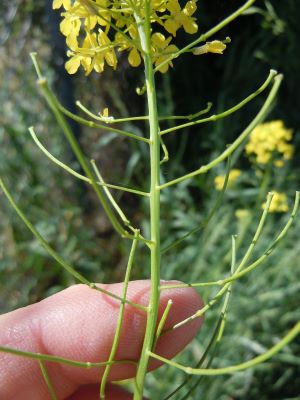Tall tumblemustard (Sisymbrium altissimum)
By Noelle Orloff, Associate Extension Specialist and Schutter Lab Diagnostician
Introduction

Photo; Matt Lavin, MSU
Tall tumblemustard is an exotic species in the mustard family. This species grows throughout Montana, inhabiting disturbed soil of grasslands, agricultural fields, streambanks, and roadsides from low to mid elevations. Tall tumblemustard has been introduced widely in North America and is thought to have originated in Eurasia.
Identification
Tall tumblemustard forms a rosette early in its life cycle. Mature plants can be up to five feet tall and are usually branched from a single stem arising from a thick taproot. Lower leaves are up to eight inches long and lobed, with a triangular lobe at the end of the leaf.Upper leaves tend to have narrower, more linear lobes. The lower

Photo; Matt Lavin, MSU
leaves and stems have sparse, long, simple hairs. Flowers are yellow with four petals. Spreading seed pods are linear, cylindrical, and up to four inches long. Occasionally weed managers may find that this plant looks similar to other weedy plants such as rush skeletonweed (Chondrilla juncea), a Montana noxious weed. Tall tumblemustard’s clear sap, four-petaled flowers, and long, linear seed pods help distinguish it from this species.
Biology, Ecology, and Impacts
Tall tumblemustard is typically a winter annual species, though some individuals may emerge in the spring. This plant can occasionally act as a biennial species. Tall tumblemustard only reproduces by seed. Seeds are dispersed when plants senesce, break off at the ground, and tumble in the wind. Tall tumblemustard is an early-seral species, meaning it can establish and become abundant in a disturbed site, but does not persist as perennial species become established.
Management
Cultural control is a great option for tall tumblemustard

Photo; Joe DiTomaso, bugwood.org
management, along with limiting seed production. Over the long term, aim to establish and maintain a perennial plant community that meets management objectives, while limiting disturbances that can increase the potential for tumblemustard establishment. For the shorter term, there are several control measures that can effectively decrease tall tumblemustard abundance. For mechanical control, handpulling prior to seed production is effective for small patches. Mowing can be helpful if timed before seeds are viable, and tillage and cultivation can also be used in certain settings to control this plant prior to seed production. There are several herbicide options available for control of tall tumblemustard in rangelands, pastures, and roadsides. For example, 2,4-D and dicamba can effectively control smaller, rapidly growing plants. Additional herbicides such as metsulfuron (e.g., Escort) can be used pre-emergence or post-emergence on young, rapidly growing plants.
Further Information
For more information about this month's weed post, contact Associate Extension Specialist Noelle Orloff. Past posts are available in the Monthly Weed Post Directory.
This weed post is also available as a printable PDF (340 KB).
